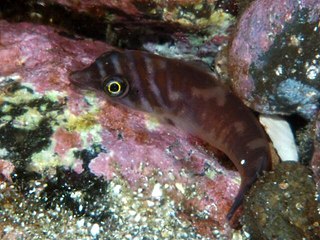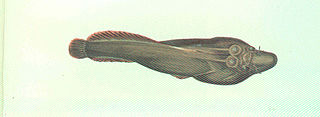The New Zealand urchin clingfish is a clingfish. It is found around New Zealand wherever sea urchins are present. Its length is between 2 and 3 cm.

Clingfishes are fishes of the family Gobiesocidae, the only family in the order Gobiesociformes. These fairly small to very small fishes are widespread in tropical and temperate regions, mostly near the coast, but a few species in deeper seas or fresh water. Most species shelter in shallow reefs or seagrass beds, clinging to rocks, algae and seagrass leaves with their sucking disc, a structure on their chest.
Dellichthys is a small genus of clingfishes from the family Gobiesocidae which are endemic to New Zealand. It had been regarded as a monotypic genus but a second species was described in 2018.
Hector's clingfish, Gastroscyphus hectoris, is a clingfish of the family Gobiesocidae, the only species in the genus Gastrocyathus. It is found all down the east coast of New Zealand around the low water mark amongst seaweed, on rocky coastlines. Its length is up to 6.4 centimetres (2.5 in) SL. This species was described in 1876 by Albert Günther as Crepidogaster hectoris from a holotype collected on the south shore of the Cook Strait. Günther honoured the Scottish-born scientist James Hector (1834-1907) who was the Director of the Geological Survey of New Zealand and who presented type to the British Museum.
The giant clingfish, Haplocylix littoreus, is a clingfish of the family Gobiesocidae, the only species in the genus Haplocylix. It is found all down the east coast of New Zealand around the low water mark amongst seaweed, on rocky coastlines. Its length is up to 15 centimetres (5.9 in). This species was originally described as Cyclopterus littoreus in 1801 by Johann Reinhold Forster, John C. Briggs subsequently placed it in the monotypic genus Haplocylix. Its closest relative appears to be the Caribbean deepwater clingfish Gymnoscyphus ascitus.

The shore clingfish, Lepadogaster lepadogaster, is a clingfish of the family Gobiesocidae. It is found in the Mediterranean Sea and adjacent Atlantic Ocean north to Galicia, Spain.

The blunt-snouted clingfish is a species of clingfish found along the Mediterranean Sea coasts from Syria to Spain. This species grows to a length of 5 centimetres (2.0 in) TL. The blunt-nosed clingfish is a little known species of shallow water along the littoral of the northern Mediterranean from Alicante to northern Israel. It can survive out of the water and occurs only among intertidal pebbles and sand.

Lepadogaster is a genus of clingfishes native to the eastern Atlantic Ocean extending into the Mediterranean Sea. Lepadogaster belongs to class Actinopterygii. This means that they share many of the same characteristics as eels, ray-finned fish, and sea horses to name a few. The main characteristic of all of them though is having fin rays. These fin rays are made of webbed skin and are attached to portions of the body that connect fins to the bones. Lepadogaster species have a distinct difference in the formation of their dorsal and anal fins. While most other ray-finned fish spines, branched fin-rays, and middle radials, Lepadogaster species do not have these. Instead, they have cartilage in place of the mentioned features. These clingfish are mainly found near the rocky coasts and inside intertidal zones. Lepadogaster is known mostly as a clingfish, meaning that it spends most of its time attached to the surface of rocks.
Opeatogenys is a genus of clingfishes. The two species occur in the eastern Atlantic Ocean with one being found also in the Mediterraean Sea.

The Posidonia clingfish is a species of clingfish native to the Australia coast. This species grows to a length of 2 centimetres (0.79 in) SL. Pale green to pale blue with fine spots forming dark reticulations on back and sides, larger blue spots often on back, and a pinkish to brown line from snout to gill cover. The posidonia clingfish is endemic to southern Australia where its range extends from Corner Inlet in Victoria west as far as Rottnest Island in Western Australia. It occurs down to a depth of 10 metres (33 ft) where it is found on macroalgae and within seagrass beds, its favoured substrate to adhere to is the leaves of the sea grass Posidonia australis. This species is the only known member of its genus and was described by John C. Briggs in 1993 with a type locality of Fiddler's Bay which is 16 kilometres south of Tamby Bay in South Australia. Briggs gave the species the specific name hutchinsi in honour of the ichthyologist Barry Hutchins of the Western Australia Museum in Perth, Western Australia.
Propherallodus briggsi is a species of clingfish native to the coasts of Japan. This species grows to a length of 3 centimetres (1.2 in) SL. This species is the only known member of its genus, it was described by Masaru Shiogaki and Yoshie Dotsu in 1983 with a type locality of Meshima Island, Japan. Its specific name honours the American ichthyologist John "Jack" C. Briggs (1920-2018).

Lepadogaster candolii, common name Connemarra clingfish, is a species of fish in the genus Lepadogaster. It occurs in the Eastern Atlantic from the British Isles south to Madeira and the Canary Islands and into the western Mediterranean and the Black Sea. The specific name candolii honours the Swiss botanist Augustin Pyramus de Candolle (1778-1841) and has various spellings: candolii, candolei, candollei, and decandollii, but only the first one is correct. Some workers have found that L. candolii is not closely related to the other two species in the genus Lepadogaster and have proposed the placing of this species in the revived monotypic genus Mirbelia Canestrini, 1864, at least until more definitive taxonomic studies can be undertaken.

Lepadogaster purpurea, the Cornish sucker, is a species of clingfish from the family Gobiesocidae. It is found in the eastern North Atlantic Ocean and in the Mediterranean Sea.
The São Tomé clingfish is a species of marine fish of the family Gobiesocidae (clingfish). It grows to 1.4 cm maximal length. It occurs in the eastern Atlantic Ocean, around the islands of São Tomé and Príncipe between 0 and 3 metres depth. The species was first described in 2007 by Ronald Fricke, its specific name honouring the collector of the type, marine biologist Peter Wirtz of Madeira.

Diplecogaster bimaculata, the two-spotted clingfish, is a species of fish in the family Gobiesocidae found in Black Sea, Mediterranean Sea and Atlantic Ocean where it is found on rocks and among seagrass or shell beds.
The dwarf shore eel is a species of clingfish from the family Gobiesocidae.It is a small species which attains a maximum total length of 4.5 centimetres (1.8 in). This species is transparent and its internal organs are clearly visible through its skin. It occurs at depths of 0 to 5 metres within beds of seagrass and sometimes in nearby reefs. It is endemic to southern Australia where its range extends from near Sydney in New South Wales to Houtman Abrolhos in Western Australia, including the northern and eastern coasta of Tasmania. This species was described by Victor G. Springer and Thomas H. Fraser in 1976 and the specific name honours the ichthyologist Douglass F. Hoese of the Australian Museum who provided Springer and Fraser with much of the material they used in their description.

Apletodon dentatus, the small-headed clingfish, is a species of clingfish from the family Gobiesocidae. It is a benthic fish of shallow, rocky water on the coasts of the eastern Atlantic Ocean and the western Mediterranean Sea.
Diplecogaster tonstricula, the Eastern Atlantic cleaner clingfish, is a species of clingfish from the family Gobiesocidae which is found in the tropical eastern North Atlantic Ocean. It has been observed cleaning larger species of fish.

Lepadichthys frenatus, the bridled clingfish, is a species of clingfish from the family Gobiesocidae. It is found on shallow reefs in the western Pacific Ocean.
Opeatogenys cadenati is a species of clingfish from the family Gobiesocidae. It occurs in the eastern Atlantic and has been recorded off Ghana, Senegal and Morocco, as well as off the Canary Islands. This species was described by John C. Briggs in 1957 with a type locality of Chenal de Joal off Senegal. Briggs honoured the French ichthyologist Jean Cadenat (1908-1992) who was Director of the Marine Biological Section of the Institut Français d’Afrique Noire in Gorée, Senegal.










